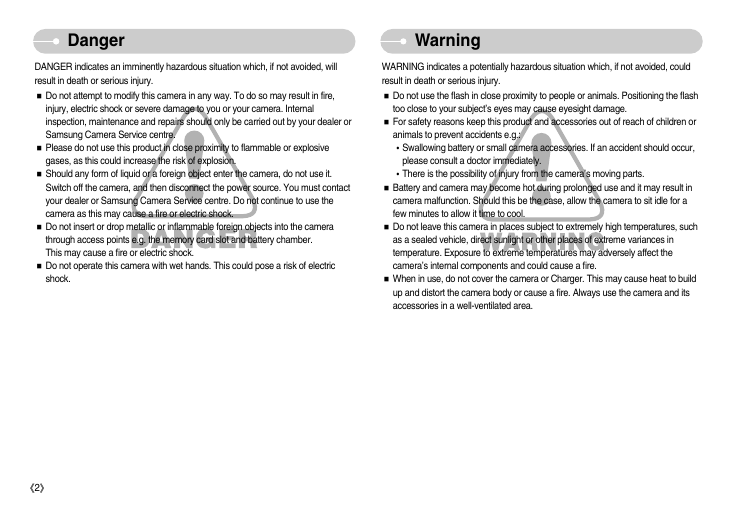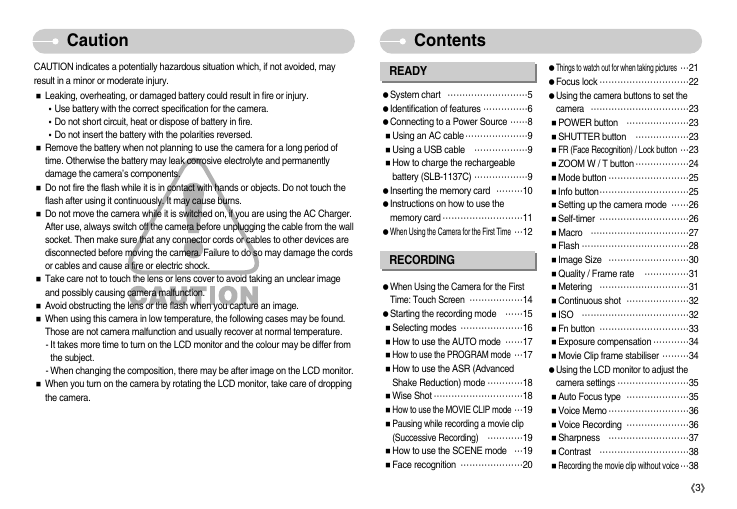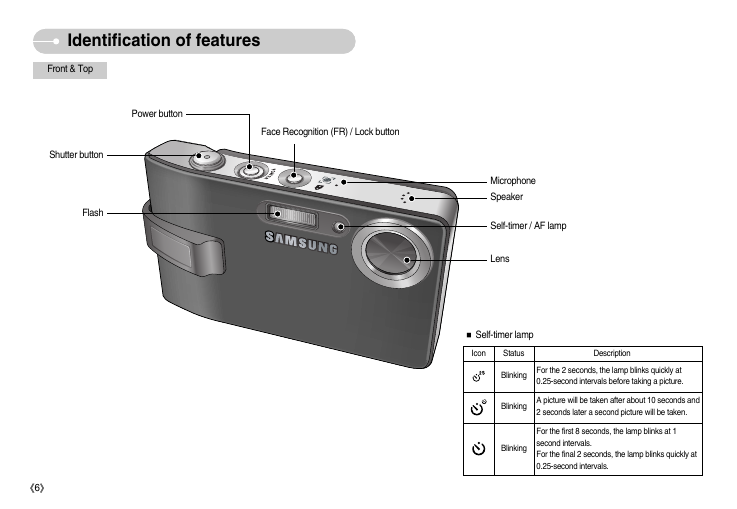User Manual
Thank you for buying a Samsung camera.
This manual will guide you through using the camera, including
capturing images, downloading images and using the application software.
Please read this manual carefully before using your new camera.
ENGLISH
�
Instructions
Use this camera in the following order.
Set up the camera driver
Before connecting the camera to a PC, via
the USB cable, you will need to set up the
camera driver. Install the camera driver
that is contained in Application software
CD-ROM. (p.111)
Take a picture
Take a picture. (p.17)
Insert the USB cable
Insert the supplied USB cable into the
PC’s USB port and the camera’s USB
connection terminal. (p.113)
Check the camera’s power
Check the camera’s power. If the power is
turned off, press the camera button to turn
it on. (p.12)
Check [Removable Disk]
Open Window’s EXPLORER and search
for [Removable Disk]. (p.114)
Getting to know your camera
Thank you for buying a Samsung Digital Camera.
Prior to using this camera, please read the user manual thoroughly.
When you require After Sales service, please bring the camera and the cause of
the camera malfunction (such as battery, Memory card etc.) to the A/S centre.
Please check that the camera is operating properly prior to when you intend to
use it (e.g. for a trip or an important event) to avoid disappointment. Samsung
camera takes no responsibility for any loss or damages that may result from
camera malfunction.
Keep this manual in a safe place.
If you use a card reader to copy the images on the memory card to your PC, the
images could be damaged. When transferring the images taken with the camera
to your PC, be sure to use the supplied USB cable to connect the camera to
your PC. Please note that the manufacturer accepts no responsibility for loss or
damage of images on the memory card due to the use of a card reader.
Microsoft, Windows and Windows logo are registered trademarks of Microsoft
Corporation incorporated in the United States and/or other countries.
is a trademark of SRS Labs, Inc.
HD
WOW HD technology is incorporated under license from SRS Labs, Inc.
All brand and product names appearing in this manual are registered trademarks.
The contents and illustrations of this manual are subject to change without prior
notice for upgrading the camera functions.
1
�
Danger
Warning
DANGER indicates an imminently hazardous situation which, if not avoided, will
result in death or serious injury.
Do not attempt to modify this camera in any way. To do so may result in fire,
injury, electric shock or severe damage to you or your camera. Internal
inspection, maintenance and repairs should only be carried out by your dealer or
Samsung Camera Service centre.
Please do not use this product in close proximity to flammable or explosive
gases, as this could increase the risk of explosion.
WARNING indicates a potentially hazardous situation which, if not avoided, could
result in death or serious injury.
Do not use the flash in close proximity to people or animals. Positioning the flash
too close to your subject’s eyes may cause eyesight damage.
For safety reasons keep this product and accessories out of reach of children or
animals to prevent accidents e.g.:
Swallowing battery or small camera accessories. If an accident should occur,
please consult a doctor immediately.
Should any form of liquid or a foreign object enter the camera, do not use it.
There is the possibility of injury from the camera’s moving parts.
Switch off the camera, and then disconnect the power source. You must contact
your dealer or Samsung Camera Service centre. Do not continue to use the
camera as this may cause a fire or electric shock.
Battery and camera may become hot during prolonged use and it may result in
camera malfunction. Should this be the case, allow the camera to sit idle for a
few minutes to allow it time to cool.
Do not insert or drop metallic or inflammable foreign objects into the camera
Do not leave this camera in places subject to extremely high temperatures, such
through access points e.g. the memory card slot and battery chamber.
This may cause a fire or electric shock.
Do not operate this camera with wet hands. This could pose a risk of electric
shock.
as a sealed vehicle, direct sunlight or other places of extreme variances in
temperature. Exposure to extreme temperatures may adversely affect the
camera’s internal components and could cause a fire.
When in use, do not cover the camera or Charger. This may cause heat to build
up and distort the camera body or cause a fire. Always use the camera and its
accessories in a well-ventilated area.
2
�
Caution
CAUTION indicates a potentially hazardous situation which, if not avoided, may
result in a minor or moderate injury.
Leaking, overheating, or damaged battery could result in fire or injury.
Use battery with the correct specification for the camera.
Do not short circuit, heat or dispose of battery in fire.
Do not insert the battery with the polarities reversed.
Remove the battery when not planning to use the camera for a long period of
time. Otherwise the battery may leak corrosive electrolyte and permanently
damage the camera’s components.
Do not fire the flash while it is in contact with hands or objects. Do not touch the
flash after using it continuously. It may cause burns.
Do not move the camera while it is switched on, if you are using the AC Charger.
After use, always switch off the camera before unplugging the cable from the wall
socket. Then make sure that any connector cords or cables to other devices are
disconnected before moving the camera. Failure to do so may damage the cords
or cables and cause a fire or electric shock.
Take care not to touch the lens or lens cover to avoid taking an unclear image
and possibly causing camera malfunction.
Avoid obstructing the lens or the flash when you capture an image.
When using this camera in low temperature, the following cases may be found.
Those are not camera malfunction and usually recover at normal temperature.
- It takes more time to turn on the LCD monitor and the colour may be differ from
the subject.
- When changing the composition, there may be after image on the LCD monitor.
When you turn on the camera by rotating the LCD monitor, take care of dropping
the camera.
Contents
READY
System chart 5
Identification of features 6
Connecting to a Power Source 8
Using an AC cable9
Using a USB cable 9
How to charge the rechargeable
battery (SLB-1137C) 9
Inserting the memory card 10
Instructions on how to use the
memory card 11
When Using the Camera for the First Time 12
RECORDING
When Using the Camera for the First
Time: Touch Screen 14
Starting the recording mode 15
Selecting modes 16
How to use the AUTO mode 17
How to use the PROGRAM mode 17
How to use the ASR (Advanced
Shake Reduction) mode 18
Wise Shot 18
How to use the MOVIE CLIP mode 19
Pausing while recording a movie clip
(Successive Recording) 19
How to use the SCENE mode 19
Face recognition 20
Things to watch out for when taking pictures 21
Focus lock 22
Using the camera buttons to set the
camera 23
POWER button 23
SHUTTER button 23
FR (Face Recognition) / Lock button 23
ZOOM W / T button24
Mode button 25
Info button25
Setting up the camera mode 26
Self-timer 26
Macro 27
Flash 28
Image Size 30
Quality / Frame rate 31
Metering 31
Continuous shot 32
ISO 32
Fn button 33
Exposure compensation 34
Movie Clip frame stabiliser 34
Using the LCD monitor to adjust the
camera settings 35
Auto Focus type 35
Voice Memo 36
Voice Recording 36
Sharpness 37
Contrast 38
Recording the movie clip without voice38
3
�
Contents
Effect39
Effect : Colour Effect 40
Effect : Image editing 42
Effect : FUN 43
PLAY
Starting play mode 49
Playing back a still image 49
Playing back a movie clip 49
Movie clip capture function 50
On camera movie trimming 50
Playing back a recorded voice 51
Playing back a voice memo 51
LCD monitor Indicator 52
Using the camera buttons to adjust
the camera 53
Play mode button53
Thumbnail/ Enlargement button /
Volume button 53
Info button55
Printer button 55
Delete icon 56
Effect: Image Editing 56
Effect: Colour 58
Effect: Image editing 60
Effect: Fun 62
Setting up the play back function
using the LCD monitor 69
Slide Show 70
4
Voice memo 72
Protecting images 73
Deleting images 74
DPOF 74
DPOF : STANDARD 75
DPOF : Index 75
DPOF : Print size76
Copy To Card 76
PictBridge 77
PictBridge : Picture Selection 78
PictBridge : Print Setting 78
PictBridge : Reset 79
Sound menu79
Sound 80
SETUP
Setup menu 81
Setup menu 1 82
File name82
LANGUAGE 83
Setting up the Date / Time / Date type 83
Imprinting the recording date 84
LCD brightness 84
Auto Focus lamp 84
Start up image 85
Setup menu 2 85
Quick view 85
Auto power off 86
LCD save 86
Calibration 87
Selecting Video out type 87
Formatting a memory 88
Initialisation 89
MP3/ PMP/ TEXT VIEWER Mode
MP3 / PMP / TEXT VIEWER Mode89
Downloading files90
Starting the MP3 / PMP / TEXT
VIEWER mode 91
LCD monitor indicator for MP3 / PMP /
TEXT VIEWER mode 92
Using the camera buttons to adjust
the camera 93
Volume button / icon 93
Play & Pause / Control icon 94
Hold button 94
Equalizer icon 95
Playlist icon 95
Setting up the playback function
using the LCD monitor 95
Play mode 96
Skin of MP3 player 96
Playing back the slide show 97
Setting slide show interval 97
Setting up the recording function in
the MP3 mode 97
Delete 98
Frame search 98
SRS 99
Auto Scroll 99
MP3 BGM Setting 100
Language setting 100
World Tour Guide 101
Download the tour guide information 101
World Tour Guide mode 101
Important notes 103
Warning indicator 104
Before contacting a service centre105
Specification 107
SOFTWARE
Software Notes 110
About the software 110
Setting up the application software 111
Starting PC mode 113
Removable Disk 114
Removing the removable disk 115
Setting up the USB Driver for MAC 116
Using the USB Driver for MAC 116
Removing the USB Driver for
Windows 98SE 116
Digimax Converter 117
Digimax Master 118
FAQ 121
�
System chart
Please check that you have the correct contents before using this product. The contents can vary depending on the sales region.
To buy the optional equipment, contact your nearest Samsung dealer or Samsung service centre.
< Included items >
Camera case
User manual,
Product warranty
Camera strap
Software CD
(see p.110~111)
Earphones
Computer
PictBridge compatible printer
(see p.77)
DPOF compatible printer
SD memory card / MMC
(see p.74)
(see p.10)
AV cable
Touch Pen
AC adapter (SAC-45) /
USB cable (SUC-C2)
Rechargeable battery
(SLB-1137C)
External monitor
(see p.87~88)
5
�
Identification of features
Power button
Face Recognition (FR) / Lock button
Front & Top
Shutter button
Flash
6
Microphone
Speaker
Self-timer / AF lamp
Lens
Self-timer lamp
Icon
Status
Description
Blinking
For the 2 seconds, the lamp blinks quickly at
0.25-second intervals before taking a picture.
Blinking
A picture will be taken after about 10 seconds and
2 seconds later a second picture will be taken.
Blinking
For the first 8 seconds, the lamp blinks at 1
second intervals.
For the final 2 seconds, the lamp blinks quickly at
0.25-second intervals.
�
Identification of features
Camera Status Lamp
Back
Zoom W (Thumbnail) / Zoom T (Digital zoom) / Volume button
LCD monitor
(Touch Screen)
Earphones jack
Camera status lamp
Status
Power on
Description
The lamp turns on and off when the camera is ready to
take a picture
After taking a picture
The lamp blinks while saving the image data and turns off
when the camera is ready to take a picture
When the USB cable is
inserted to a computer
The lamp is on (The lamp will be turned off after
recognising the camera)
Transmitting Data
with a PC
When the USB cable
is inserted to a printer
When the printer is
printing
When the AF
activates
The lamp is off (LCD monitor turns off)
The lamp turns on
The lamp blinks
The lamp turns on
(The camera focus on the subject)
The lamp blinks
(The camera doesn't focus on the subject)
Mode button
Camera strap
Infomation button
Playback mode / Printer button
Do not rotate the LCD clockwise. It cause LCD breakage. The LCD can be rotate count-clockwise (upto 180)
7
�
















 2023年江西萍乡中考道德与法治真题及答案.doc
2023年江西萍乡中考道德与法治真题及答案.doc 2012年重庆南川中考生物真题及答案.doc
2012年重庆南川中考生物真题及答案.doc 2013年江西师范大学地理学综合及文艺理论基础考研真题.doc
2013年江西师范大学地理学综合及文艺理论基础考研真题.doc 2020年四川甘孜小升初语文真题及答案I卷.doc
2020年四川甘孜小升初语文真题及答案I卷.doc 2020年注册岩土工程师专业基础考试真题及答案.doc
2020年注册岩土工程师专业基础考试真题及答案.doc 2023-2024学年福建省厦门市九年级上学期数学月考试题及答案.doc
2023-2024学年福建省厦门市九年级上学期数学月考试题及答案.doc 2021-2022学年辽宁省沈阳市大东区九年级上学期语文期末试题及答案.doc
2021-2022学年辽宁省沈阳市大东区九年级上学期语文期末试题及答案.doc 2022-2023学年北京东城区初三第一学期物理期末试卷及答案.doc
2022-2023学年北京东城区初三第一学期物理期末试卷及答案.doc 2018上半年江西教师资格初中地理学科知识与教学能力真题及答案.doc
2018上半年江西教师资格初中地理学科知识与教学能力真题及答案.doc 2012年河北国家公务员申论考试真题及答案-省级.doc
2012年河北国家公务员申论考试真题及答案-省级.doc 2020-2021学年江苏省扬州市江都区邵樊片九年级上学期数学第一次质量检测试题及答案.doc
2020-2021学年江苏省扬州市江都区邵樊片九年级上学期数学第一次质量检测试题及答案.doc 2022下半年黑龙江教师资格证中学综合素质真题及答案.doc
2022下半年黑龙江教师资格证中学综合素质真题及答案.doc